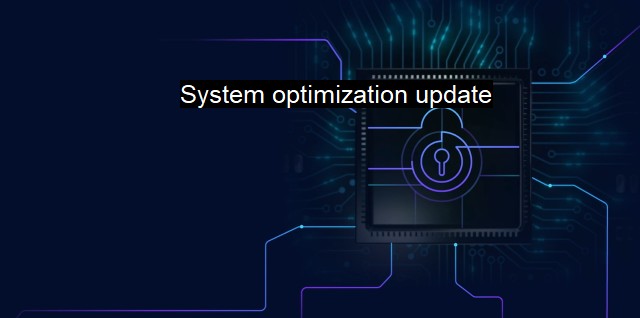What is System optimization update?
Maximizing Cybersecurity: The Importance of System Optimization Updates for Achieving High Performance, Efficiency, and Protection Against Cyber-Attacks
System Optimization Update is a fundamental aspect of cybersecurity and antivirus functionality that ensures the efficient and effective running of the computer system or network. In our rapidly evolving digital climate, marked by increasingly sophisticated cyber threats, having optimized systems is mission-critical for personal, corporate, and state-level data protection. There are four key facets to understand about a System Optimization Update within a cybersecurity and antivirus framework: its content, its usefulness, the risks associated without it, and the perspectives on implementing it smoothly.System optimization updates essentially serve to enhance the health and productivity of systems by addressing areas such as coding structure, disk space, memory, and patches. They come in various forms, from updating outdated file versions and software, repairing bugs, rectifying operating system efficiency issues, through to removing redundant or temporary files, and subsequently freeing up space. Facilitated by software providers or antivirus programs, these updates allow operational systems to handle tasks swiftly and easily, improving the overall performance of computers.
They're indispensable in maximizing the positive impact of one's cybersecurity strategy and antivirus protection. It’s due to their effectiveness in resolving bugs, security vulnerabilities, and other weak points that could otherwise be manipulated by cybercriminals to overrun systems. Efficiency bumps provided by these updates can help speed up cybersecurity processes, enhancing danger discovery and response times, ultimately reducing the scope of potential damage cyber threats can cause to one's system.
Neglecting system optimization updates exposes an individual or organization to accumulating technical issues on multiple fronts. Over time, these could snowball into more significant complications and performance lags, notably obstructing systems' cybersecurity readiness. This could transform into easy opportunities for hackers looking for weak spots to exploit, such as outdated code, gaps between network devices, or straightforward system vulnerabilities.
Performance could deteriorate cumulatively, impairing the system's capacity to combat new breeds of cyber threats effectively. Consequences might include a substantial slowdown of operations, internally as well as when interacting externally, or even a complete halt to the system over time. From the antivirus perspective, without optimization updates, this software ineffectiveness may allow malware to embed undetected, and subsequently orchestrate further dangerous activities, such as data theft and network assault.
Ensuring seamless implementation of these updates is necessary to keep the disruptions that typically come along with technical enhancements to a minimum. A significant factor to consider is scheduling these updates at times when system usage is low to avoid momentary and often frustrating operational difficulties during critical work hours.
Being prudent with source validation is imperative to avoid downloading fraudulent updates that might cause more harm than good. Always rely on updates from authentic software providers and established antivirus programs. If the update arrives via email, ensure the source is trustable. Don’t click suspicious links or download files without confirming its authenticity.
Taking advantage of antivirus features regarding update management could provide an intelligent way to ease the burden. Some antivirus software could either set towards the automatic implementation of smaller, regular updates over disruptive dust-and-all, or even micro-patch where needed, satisfying unique security needs without overload.
System optimization update represents a critical piece of efficient cybersecurity and robust antivirus protection. Updating supports system health and responsiveness, improves working performances, and, significantly, plugs leaks to fend off opportunistic cyber threats. Implementing the more seamless application of these updates, while keeping alert against associated hazards such as fraudulent updates, represents a forward-thinking contribution to the contemporary cybersecurity playbook. Therefore, the role of optimization updates in robust protective strategies shouldn’t be understated or overlooked.

| | A | | | B | | | C | | | D | | | E | | | F | | | G | | | H | | | I | | | J | | | K | | | L | | | M | |
| | N | | | O | | | P | | | Q | | | R | | | S | | | T | | | U | | | V | | | W | | | X | | | Y | | | Z | |
| | 1 | | | 2 | | | 3 | | | 4 | | | 7 | | | 8 | | |||||||